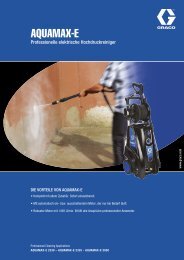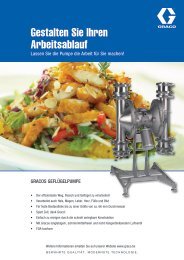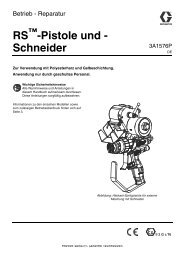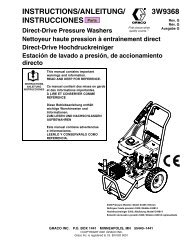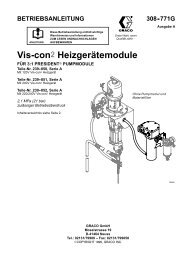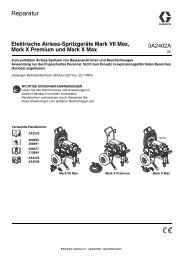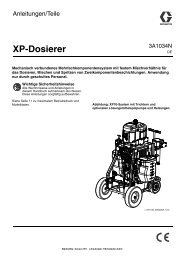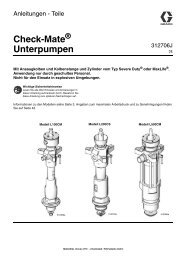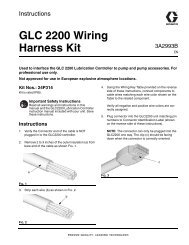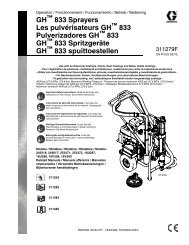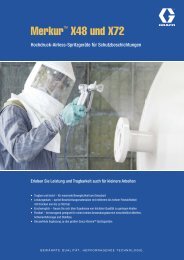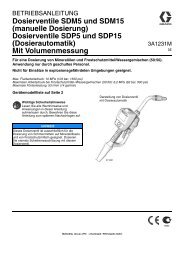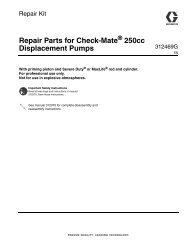307889K ULTRA 500 AIRLESS PAINT SPRAYER - Graco Inc.
307889K ULTRA 500 AIRLESS PAINT SPRAYER - Graco Inc.
307889K ULTRA 500 AIRLESS PAINT SPRAYER - Graco Inc.
You also want an ePaper? Increase the reach of your titles
YUMPU automatically turns print PDFs into web optimized ePapers that Google loves.
MOTOR IS HOT AND RUNS INTERMITTENTLY<br />
TYPE OF PROBLEM<br />
Motor is hot and runs intermittently.<br />
ELECTRICAL SHORT<br />
WHAT TO CHECK<br />
If check is OK, go to next check<br />
1. Determine if sprayer was operated at high<br />
pressure with small tips, which causes low<br />
motor RPM and excessive heat build up.<br />
2. Be sure ambient temperature where sprayer<br />
is located is no more than 32C (90F) and<br />
sprayer is not located in direct sun.<br />
3. Determine if sprayer was turned on, pressurized,<br />
but not operating for long periods of time.<br />
WHAT TO DO<br />
When check is not OK refer to this column<br />
1. Decrease pressure setting or increase tip<br />
size.<br />
2. Move sprayer to shaded, cooler area if possible.<br />
3 Turn off sprayer whenever you stop spraying<br />
for a while and relieve fluid pressure.<br />
TYPE OF PROBLEM<br />
Building circuit breaker opens<br />
as soon as sprayer switch is<br />
turned on.<br />
CAUTION<br />
Any short in any part of the<br />
motor power circuit will cause<br />
the control circuit to inhibit<br />
sprayer operation. Correctly<br />
diagnose and repair all shorts<br />
before checking and replacing<br />
control board.<br />
Building circuit breaker opens<br />
as soon as sprayer is plugged<br />
into outlet and sprayer is NOT<br />
turned on.<br />
Sprayer quits after sprayer operates<br />
for 5 to 10 minutes.<br />
WHAT TO CHECK<br />
If check is OK, go to next check<br />
1. Check all electrical wiring for damaged insulation,<br />
and all terminals for loose fit or damage.<br />
Also check wires between pressure control<br />
and motor which are encased in conduit (1).<br />
See page 26.<br />
2. Check for missing inspection plate gasket<br />
(see page 26), bent terminal forks or other<br />
metal to metal contact points which could<br />
cause a short.<br />
3. Check motor armature for shorts. Use an armature<br />
tester (growler) or perform spin test.<br />
See page 16. Inspect windings for burns.<br />
4. Check pressure control board (301) by substituting<br />
with a good control board. See page 22.<br />
WHAT TO DO<br />
When check is not OK refer to this column<br />
1. Repair or replace any damaged wiring or<br />
terminals. Securely reconnect all wires.<br />
2. Correct faulty conditions.<br />
3. Replace motor. See page 26.<br />
4. Replace with a new pressure control board<br />
(301). See page 22.<br />
1. Check Basic Electrical Problems on page 12. 1. Perform necessary procedures.<br />
2. Check ON/OFF switch (307) See page 21. Be<br />
sure the sprayer is unplugged! Disconnect<br />
wires from switch. Check switch with ohmmeter.<br />
The reading should be infinity with the ON/<br />
OFF switch OFF, and zero with the switch ON.<br />
3. Check for damaged or pinched wires in the<br />
pressure control. See page 22.<br />
2. Replace ON/OFF switch. See page 21.<br />
3. Replace damaged parts. See page 22.<br />
1. Check Basic Electrical Problems on page 12. 1. Perform necessary procedures.<br />
2. Check electrical supply with volt meter. Meter<br />
should read 200 to 250 VAC.<br />
3. Check tightness of pump packing nut. Overtightening<br />
tightens packings on rod, restricts<br />
pump action, and damages packings.<br />
2. If voltage is too high, do not operate<br />
sprayer until corrected.<br />
3. Loosen packing nut. Check for leaking<br />
around throat. Replace pump packings, if<br />
necessary. See page 28.<br />
Spin Test<br />
WARNING<br />
ELECTRIC SHOCK HAZARD<br />
Do not touch the brushes, leads, springs<br />
or brush holders while the sprayer is<br />
plugged in to reduce the risk of electric<br />
shock and serious bodily injury.<br />
WARNING<br />
INJECTION HAZARD<br />
To reduce the risk of serious injury,<br />
follow the illustrated Pressure Relief<br />
Procedure warning on page 12 whenever<br />
you are instructed to relieve pressure.



